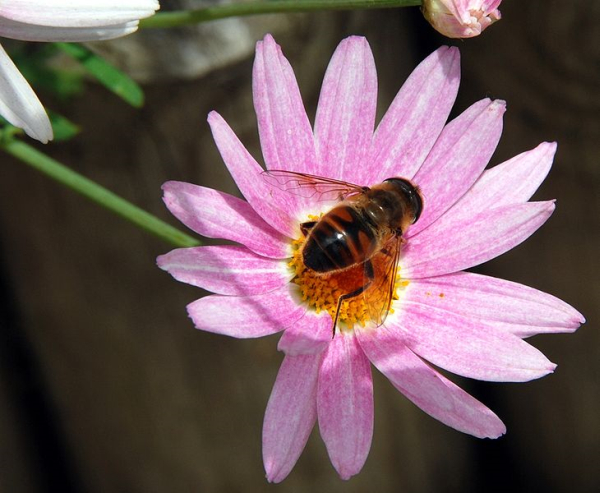On Wednesday I blogged about Sundrops and included a photo of a flower with a honeybee on it — or so I thought. Fortunately Monica Miller pointed out my mistake (which I corrected) and I learned something new.
This bug is a honeybee mimic who looks so similar he’s often mistaken for one. He’s the same size as a honeybee and has a dark brown body with orange-yellow patches covered in short hairs. He hovers like a bee and he feeds on nectar.
But he’s a drone fly, a member of the family Syrphidae also known as hover flies. This one is in the genus Eristalis and is probably the most common species, Eristalis tenax, but drone flies are so hard to tell apart that it’s beyond the capabilities of someone like me who only just learned they aren’t bees!
How do you tell the difference between a drone fly and a honeybee? The drone fly is a “true fly” so he has:
- only one pair of wings
- large eyes (which happen to have a row of upright hairs on them)
- no waistline (honeybees have a narrow waist)
- inconspicuous antennae
- and no sting!
In the larval stage you’ll never mistaken a drone fly for a honeybee. Drone fly larvae live in stagnant water and feed on decaying organic material. The water they prefer is so low in oxygen that they have tubes on their rear ends that they raise to the surface to breathe. This gives them the nickname rat-tailed maggots. Eeeeeew! They like manure pits.
Drone fly adults are good pollinators so perhaps that’s why they were introduced into North America around 1875.
I don’t know how they got here, but I do know I prefer to meet them as adults.
(photo by Alvesgaspar from Wikimedia Commons. Click on the photo to see the original)

Well I was fooled too. Just assumed it was a honeybee; 1. because you said so and 2. because it looks like one. Have a happy 4th.